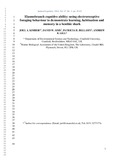JavaScript is disabled for your browser. Some features of this site may not work without it.
| dc.contributor.author | Kimber, Joel A. | - |
| dc.contributor.author | Sims, David W. | - |
| dc.contributor.author | Bellamy, Patricia H. | - |
| dc.contributor.author | Gill, Andrew B. | - |
| dc.date.accessioned | 2014-05-31T04:00:53Z | |
| dc.date.available | 2014-05-31T04:00:53Z | |
| dc.date.issued | 2014-01-31T00:00:00Z | - |
| dc.identifier.citation | Joel A. Kimber, David W. Sims, Patricia H. Bellamy and Andrew B. Gill. Elasmobranch cognitive ability: using electroreceptive foraging behaviour to demonstrate learning, habituation and memory in a benthic shark. Animal Cognition, 2014, Vol. 17, No. 1, pp. 55-65 | |
| dc.identifier.issn | 1435-9448 | - |
| dc.identifier.uri | http://dx.doi.org/10.1007/s10071-013-0637-8 | - |
| dc.identifier.uri | http://dspace.lib.cranfield.ac.uk/handle/1826/8486 | |
| dc.description.abstract | Top predators inhabiting a dynamic environment, such as coastal waters, should theoretically possess sufficient cognitive ability to allow successful foraging despite unpredictable sensory stimuli. The cognition-related hunting abilities of marine mammals have been widely demonstrated. Having been historically underestimated, teleost cognitive abilities have also now been significantly demonstrated. Conversely, the abilities of elasmobranchs have received little attention, despite many species possessing relatively large brains comparable to some mammals. The need to determine what, if any, cognitive ability these globally distributed, apex predators are endowed with has been highlighted recently by questions arising from environmental assessments, specifically whether they are able to learn to distinguish between anthropogenic electric fields and prey bioelectric fields. We therefore used electroreceptive foraging behaviour in a model species, Scyliorhinus canicula (small-spotted catshark), to determine cognitive ability by analysing whether elasmobranchs are able to learn to improve foraging efficiency and remember learned behavioural adaptations. Positive reinforcement, operant conditioning was used to study catshark foraging behaviour towards artificial, prey-type electric fields (Efields). Catsharks rewarded with food for responding to Efields throughout experimental weeks were compared with catsharks that were not rewarded for responding in order to assess behavioural adaptation via learning ability. Experiments were repeated after a 3-week interval with previously rewarded catsharks this time receiving no reward and vice versa to assess memory ability. Positive reinforcement markedly and rapidly altered catshark foraging behaviour. Rewarded catsharks exhibited significantly more interest in the electrical stimulus than unrewarded catsharks. Furthermore, they improved their foraging efficiency over time by learning to locate and bite the electrodes to gain food more quickly. In contrast, unrewarded catsharks showed some habituation, whereby their responses to the electrodes abated and eventually entirely ceased, though they generally showed no changes in most foraging parameters. Behavioural adaptations were not retained after the interval suggesting learned behaviour was not memorised beyond the interval. Sequences of individual catshark search paths clearly illustrated learning and habituation behavioural adaptation. This study demonstrated learning and habituation occurring after few foraging events and a memory window of between 12 h and 3 weeks. These cognitive abilities are discussed in relation to diet, habitat, ecology and anthropogenic Efield sources. © 2013 Springer-Verlag Berlin Heidelberg. | en_UK |
| dc.publisher | Springer Science Business Media | en_UK |
| dc.rights | The original publication is available at www.springerlink.com | |
| dc.title | Elasmobranch cognitive ability: using electroreceptive foraging behaviour to demonstrate learning, habituation and memory in a benthic shark | en_UK |
| dc.type | Article | - |
Files in this item
This item appears in the following Collection(s)
-
Staff publications (SAS) [907]
